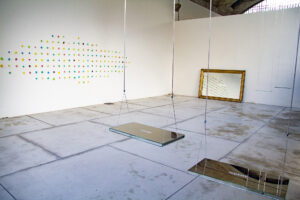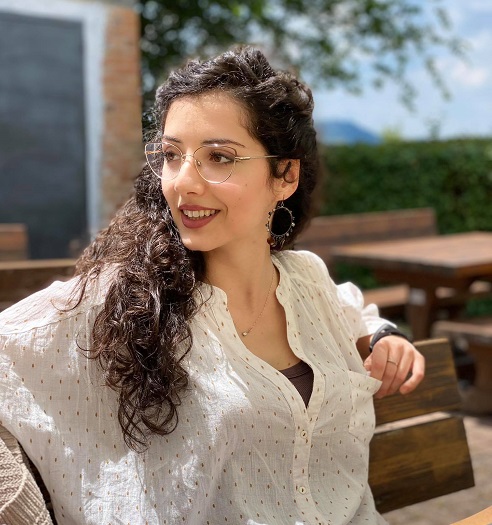The artistic duo, composed of Nadia Antonello and Paolo Ghezzi, returns to the ME Vannucci Gallery in Pistoia with a solo exhibition curated by Manuela Valentini. Amore libera tutti (Love frees everyone) is the title of the exhibition – open until February 14 – which transforms the post-industrial environments of the gallery into a poem of love. Instead of words, 13 works that invite us to reflect on the universal value of love as a bond between people. In a delicate moment like this, the installations on display acquire an even deeper meaning: they become bridges to shorten distances.
Emblematic of this is certainly the installation Stringere lo spazio (di me e te) / Tighten the space (of me and you) (2020), a wall full of small terracotta sculptures created during a performance held last summer, during which people, gathered two at a time, held in hand a fragment of clay. The tangible imprints of emotional relationships thus become a work of art.
The sentiment is on display in different forms. It is romanticism, it is lightness, it is purity. And who better than children can live all this candidly and without shame? The title of the exhibition refers to childhood, which is inspired by the game of hide and seek, but not only. Also the Altalene/ Swings (2020) that present phrases like Sempre Insieme (2020), Spingiamoci Oltre (2020) and Tienimi Forte (2020) engraved on mirrors.
The mirror is the recurring element in the works of the two artists. Write me (2020), for example consists of a mirror set in a window and a wooden desk. It is the mirror itself that invites the viewer to sit down to write a letter that the gallery owner will then send. A simple gesture, almost countertrend in the digital age we live in, which invites us to stop and impress, in black and white, often unexpressed feelings.
Waiting for love / Attesa dell’amore (2020) also features a mirror, not just any one. In this case, the artists have given life to a mirror recently found by the owners of the gallery in an old warehouse and which, in the 1920s, furnished the waiting room of the Pistoia railway station. And the symbolism is strong and clear: how many encounters and how many farewells will be reflected on that surface?
Art has the task of transporting us to another universe made of dreams, fantasy, poetry. A universe in which love is a game, an antidote and freedom.
We asked some questions directly to the artists.
Ornella D’Agnano: When was the project Amore libera tutti born? How much has the moment of emergency we are experiencing influenced the construction of the works?
Antonello Ghezzi: Amore libera tutti was born a long time ago, when the Vannucci Gallery was opening the new beautiful space in Pistoia. We wanted to create works that had Love as a theme. It was almost two years ago, we went by car to talk about our first ideas, first of all, the desk for writing love letters. We did not imagine that a pandemic would come that would make us all more alone, distant and fragile. This moment influences the new meanings that the works acquire, as often happens, as if decades had passed since their birth.
Stringere lo spazio (tra me e te) is an installation made up of a series of small terracotta sculptures and is the result of a performance, held last summer, which involved the public called in pairs to hold a fragment of clay. How was it for you and for the public to return – after the first lockdown – to such a tangible form of contact, which was destined to become a work of art?
When we conceived this project, we were anxious that the climax of the performance, while the two people shake hands, was a solemn act, like a secular wedding, an official promise where the master of ceremonies are the lovers themselves. Being able to meet and touch again after the first lockdown has given this sacredness. Shaking hands and getting closer was experienced as a really important thing. Later it was wonderful to let oneself abandon to the contemplation of all those small sculptures, colored and full of shapes that evoke fingers, palms, footprints, rings, bodies after all, but above all the space between two people who, like two magnets, attract each other and cancel that space.
Often yours are relational works. I am thinking above all of Stringere lo spazio (tra me e te) (2020), but also of the Altalene (2020) or of Scrivimi (2020), a work that consists of a mirror and a desk and that invites the viewer, equipped with paper and pen, to write a letter to actually send to a loved one. The other is fundamental in your work. How was it and how is it for you to face the condition of distance and closure which we are forced to face?
If we think of the great projects we have carried out, our door that opens to a smile would be hindered by the mask, in the collective performances to tear down the walls of the world where as the only weapon we had chosen myriads of people while blowing soap bubbles, now they would arrest us for procured epidemic! The other has always been fundamental in all our works, but the other has not disappeared. The opening of the exhibition on December 19th was an act of courage that we shared with the gallery owner Massimiliano Vannucci, but also a form of poetic resistance. It is in our power to do so, as well as being able to imagine and emphasize our love for relationships once more, this is granted to us and we will do it. Love frees everyone and Art saves, I would add.
Frequently your works are site-specific. On this occasion, you exhibit in the ME Vannucci Gallery in Pistoia, a post-industrial space that for some time was the headquarters of the Storai company. How important is the space in which you operate for you? How much does this influence or inspire your production?
The gallery spaces are beautiful, we were able to bring down the swings from very high, as if they were Foucault’s pendulums. When night falls we put Billie Holiday, Duke Ellington, George Gershwin and make them dance. Then the magic comes out. The presence of the workshops can be felt, the traces on the walls, on the floor, but the atmospheres left by the latest exhibitions are more vivid, the presence before us of Sandra Tomboloni, Luigi Mainolfi, Luca Caccioni, Fabrizio Corneli … It is as if each had left some luminous dust that can be felt. And speaking of dust and evocative spaces, we had a great privilege, that of working on a large mirror that has been in the waiting room of the Pistoia station since 1851 to now become the work Attesa dell’amore.
In the title – which evokes the game of hide and seek – and in all the works on display there is an intrinsic sense of poetic lightness. A lightness that makes us think of Calvino’s words: “it is not superficiality, but gliding over things from above, not having boulders on the heart”. A delicate and sensitive way to bring out and bring to light values that unite us all. You launch a message of strong positivity. In your opinion, is this the key to reacting to the difficult contemporary situation? Is love the answer?
Loving and imagining can be synonymous. Making what usually exists only in fairy tales happen comes from our great need, our work allows us to invent different worlds for when things are too bad or too difficult. And art is basically a great act of love.
Ornella D’Agnano
Info:
Antonello Ghezzi. Amore Libera Tutti (Love frees everyone)
19/12/2020 – 28/03/2021
Galleria ME Vannucci
Via Gorizia 122, Pistoia
 Nadia Antonello and Paolo Ghezzi, ph. Carta Bianca
Nadia Antonello and Paolo Ghezzi, ph. Carta Bianca
 Antonello Ghezzi, Amore libera tutti, installation view. In the picture: “Sempre insieme”, 2020; “Stringere lo spazio (di me e te)”, 2020; “Attesa dell’amore”, 2020. Ph Massimiliano Vannucci
Antonello Ghezzi, Amore libera tutti, installation view. In the picture: “Sempre insieme”, 2020; “Stringere lo spazio (di me e te)”, 2020; “Attesa dell’amore”, 2020. Ph Massimiliano Vannucci
 Antonello Ghezzi, Amore libera tutti, installation view. In the picture: “Sempre insieme”, 2020; “Scrivimi”, 2020. Ph Massimiliano Vannucci
Antonello Ghezzi, Amore libera tutti, installation view. In the picture: “Sempre insieme”, 2020; “Scrivimi”, 2020. Ph Massimiliano Vannucci
 Antonello Ghezzi, Attesa dell’amore, 2020, mirror and antique frame, 226 x 150 cm. Ph Fabrizio Romano
Antonello Ghezzi, Attesa dell’amore, 2020, mirror and antique frame, 226 x 150 cm. Ph Fabrizio Romano
 Antonello Ghezzi, Scrivimi, 2020, window, wood, mirror, 150 x 177 cm. Ph Massimiliano Vannucci
Antonello Ghezzi, Scrivimi, 2020, window, wood, mirror, 150 x 177 cm. Ph Massimiliano Vannucci

Born in Puglia (Italy), after a three-year degree in Cultural Heritage at the University of Salento (Lecce), she deepened her study of contemporary art, graduating in Visual Arts at the University of Bologna, where she currently lives and works. Author of the critical essay “Museum and Neutrality”. Member of the Muri di Versi Cultural Association. She believes that art is a powerful tool capable of arousing reflections and creating relationships.






NO COMMENT